 87
87
Samsung 9100 Pro 2 TB Review - The Best Gen 5 SSD
Windows 11 Startup, Virtualization & File Compression »Thermal Throttling
Due to the compact form factor, M.2 drives lack the ability to actively cool themselves, usually having to rely on passive airflow instead. All vendors include some form of thermal throttling on their drives as a safeguard, which limits throughput once a certain temperature is exceeded.On this page, we will investigate whether the tested drive has such a mechanism, how high temperatures get, and what effect this has on performance. We will test the drive in a typical case, installed in the M.2 slot between the CPU and VGA card, while it's getting hammered by non-stop incoming writes. A first test run, to create a baseline, shows temperature and performance with a 120 mm fan directly blowing on the tested drive. In a second run we report thermal performance of the completely uncooled drive. Each of the charts has time moving from left to right, with the blue line displaying transfer speed in MB/s and the red line showing the temperature in degrees Celsius (measured using SMART).
Results from this test setup are not comparable to our older SSD benches because we're using a different case and an AIO watercooling unit, so there's very little airflow inside the case.
Bare Drive without Heatsink
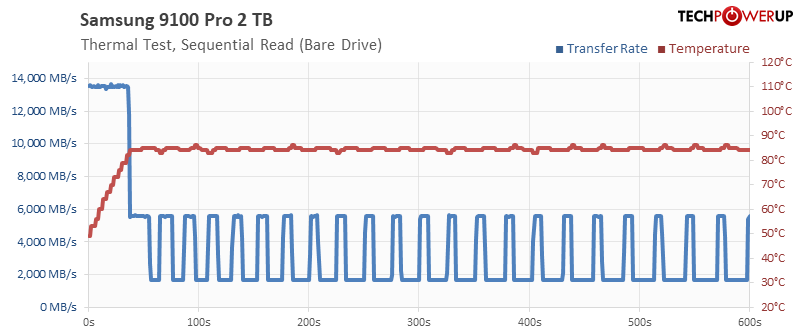
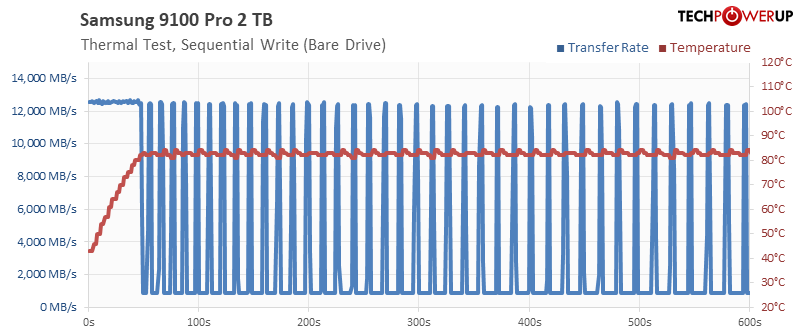
Samsung ships this variant of their drive without a heatsink, so I ran our first test without the heatsink, without any additional airflow. As you can see, the drive throttles fairly quickly. On the other hand, if you have only light workloads that last for less than a minute, then throttling won't be an issue. While writes are pretty slow with 1 GB/s during throttling, reads are quite alright with 2-5 GB/s.
Drive with Thermalright Heatsink
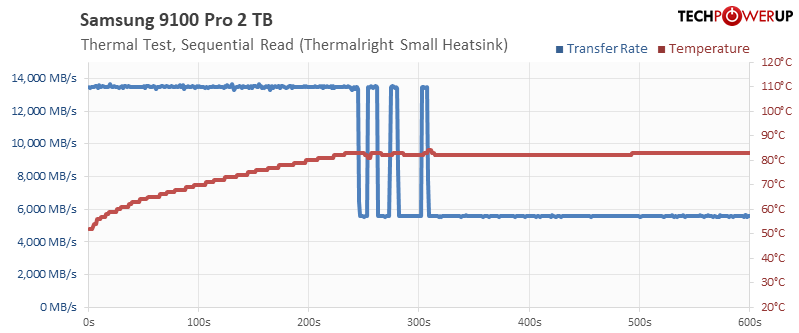
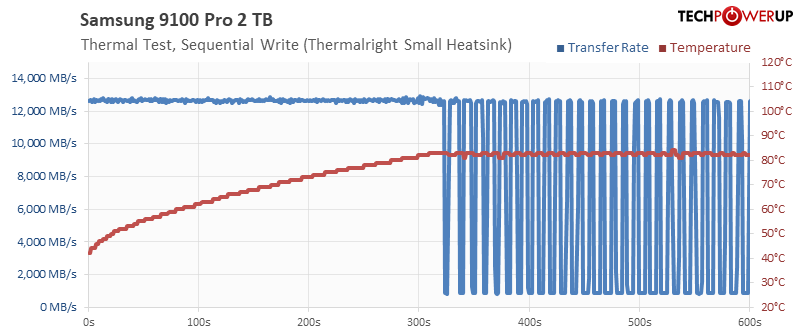
Next, I installed a Thermalright TR-M2, which is a compact full-metal heatsink. Still quite some throttling, but much better.
Drive with big Thermalright Heatsink
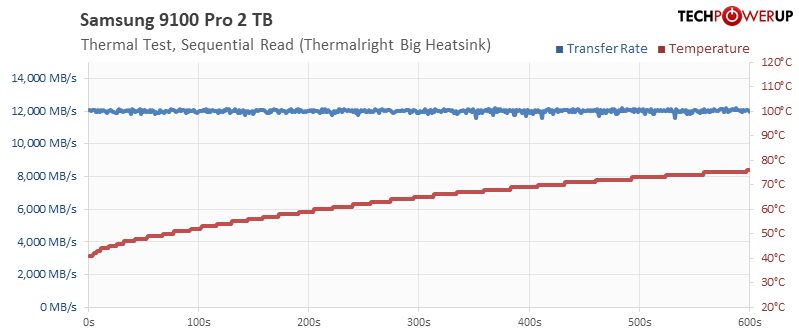
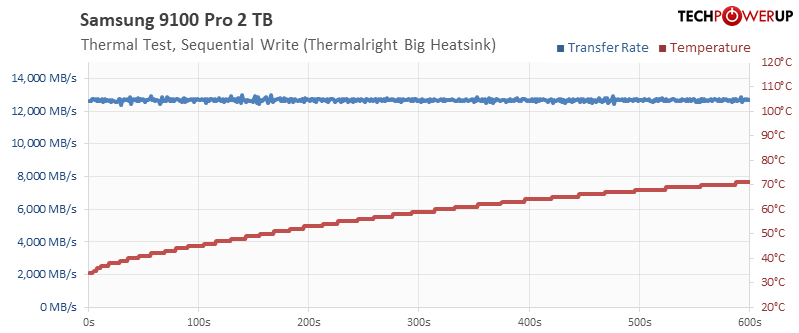
With the much bigger Thermalright HR-10, there is no more throttling.
Drive with Fan
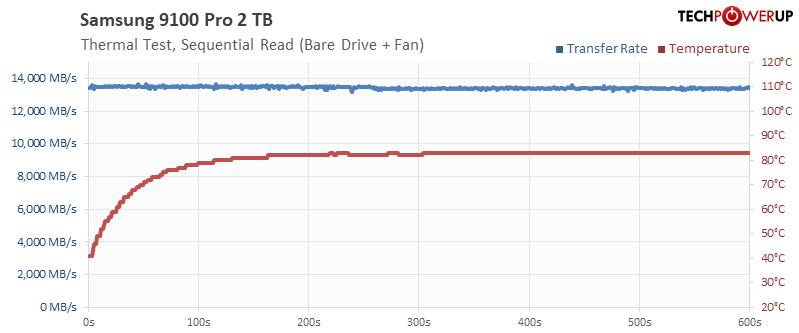
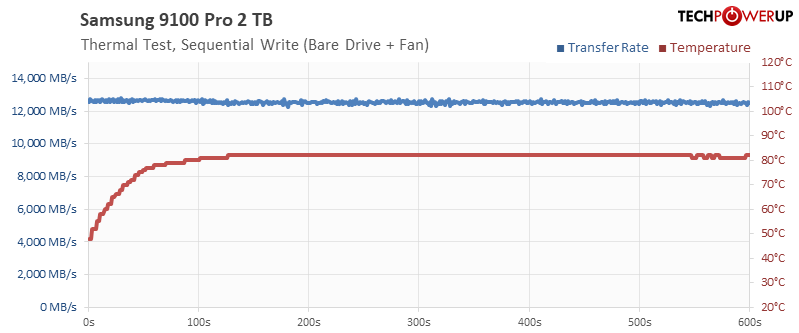
Finally, as control, I put a big 80 mm fan in front of the drive without heatsink, no throttling here, either.
Thermal Image & Hot Spot
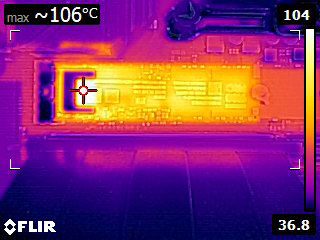
We recorded a thermal image of the running SSD as it was completing the write test. The surface temperature of the drive reached 106°C, which is much higher than what the thermal sensor reports. Do note that two sensors are exposed, but both show exactly the same value.
Jul 29th, 2025 06:14 CDT
change timezone
Latest GPU Drivers
New Forum Posts
- Windows 10 Vs 11, Which one to choose? (257)
- AMD EXPO Memory issue Suddenly After 7months usage (39)
- Which Linux flavor? (79)
- PC upgrade after many years (4)
- Anime Nation (13065)
- Kindly help me to complete my new PC build... (20)
- 3D Printer Club (568)
- RTX 5000 Super series predictions and speculation. (1)
- Mouse and CPU usage. (12)
- What's your latest tech purchase? (24387)
Popular Reviews
- Herman Miller Logitech G Embody Review - No Pain, No Gain
- Lian Li O11 Dynamic Mini V2 Review
- Upcoming Hardware Launches 2025 (Updated May 2025)
- Noctua NF-A12x25 G2 PWM Fan Review
- VAXEE XE V2 Wireless Review
- AQIRYS Sirius Pro Review
- Sapphire Radeon RX 9060 XT Pulse OC 16 GB Review - An Excellent Choice
- AMD Ryzen 7 9800X3D Review - The Best Gaming Processor
- NVIDIA GeForce RTX 5050 8 GB Review
- UPERFECT UMax 24 Review
TPU on YouTube
Controversial News Posts
- AMD's Upcoming UDNA / RDNA 5 GPU Could Feature 96 CUs and 384-bit Memory Bus (134)
- AMD Radeon RX 9070 XT Gains 9% Performance at 1440p with Latest Driver, Beats RTX 5070 Ti (131)
- NVIDIA GeForce RTX 5080 SUPER Could Feature 24 GB Memory, Increased Power Limits (115)
- Intel "Nova Lake-S" Core Ultra 3, Ultra 5, Ultra 7, and Ultra 9 Core Configurations Surface (109)
- NVIDIA DLSS Transformer Cuts VRAM Usage by 20% (100)
- DDR6 Memory Arrives in 2027 with 8,800-17,600 MT/s Speeds (99)
- AMD Sampling Next-Gen Ryzen Desktop "Medusa Ridge," Sees Incremental IPC Upgrade, New cIOD (97)
- Intel CEO Confirms SMT To Return to Future CPUs (95)